





Many Euphorbia species are grown in cultivation in pots in protected greenhouses and cold frames. But can any of these survive outdoors in the warmer temperate climates? The following article briefly summarizes my experience growing a few of these smaller species outdoors in a Mediterranean climate.
When I want to landscape a small area with succulents, or even grow some unusual succulents in pots, I always have questions about cold hardiness, watering schemes, sun protection etc. when collecting such succulents. However, rarely do any succulent sources have much, if any, information about how to grow these Euphorbias. I realize there are literally hundreds of species of small Euphorbia and there just is no way to know a lot about them unless you have personally tried growing them all... and I certainly have not. But, after more than 10 years of experimenting--many times unsuccessfully--with various Euphorbias, I have learned that some do well outdoors as landscape or potted plants here in southern California, and others do not. The following is a general summary of some of the plants of which I have had at least some experience growing outdoors (as I have no indoor plants or greenhouse, so everything I grow is outdoors whether it likes it or not). Also I will try to give some pointers, at least if I know them myself, on how to tell them apart, too, as many times these plants are mixed up or improperly identified by nurseries and collectors. This discussion will be limited to the small columnar and globoid varieties and only the more common ones that I have had some experience with, as there are far too many Euphorbias to cover in a short article. I will try to go over some other Euphorbias in later articles. Some of the plants below are included only because in MY climate they are short, columnar species. In more tropical climates some of these could be large trees.
Euphorbia aggregata is a short suckering plant with ribbed columns about 2 to 4 inches tall and 1 inch diameter, generally about 10 ribs per column, dull green with randomly spaced, stout pale, solitary spikes about a half-inch long. This plant resembles Euphorbia ferox but spines are less common, plant is shorter and spines have no obvious purple in them. The flowers are yellow-green. It seems cold hardy to at least 28F, and probably lower.
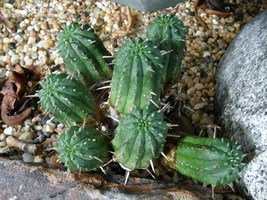
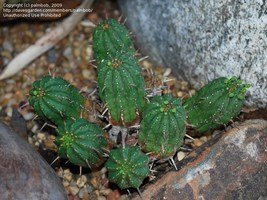 Euphorbia aggregata in my yard
Euphorbia aggregata in my yard
Euphorbia anoplia is a commonly grown landscape or potted plant in southern California. It has suckering, spineless, symmetrical, bright-green columns with prominent variegated horizontal banding. Generally it forms 5 to 8 vertical ribs and columns grow up to 10 inches tall and 3 inches in diameter.. Flowers are maroon/purple. This plant is often misidentified as Euphorbia polygona or Euphorbia horrida. The cold-hardiness of this species is excellent, being at least down to 25F if not lower, and it is widely available.
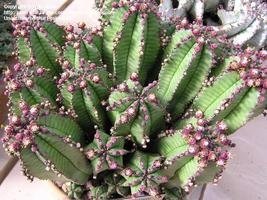
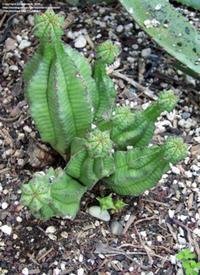
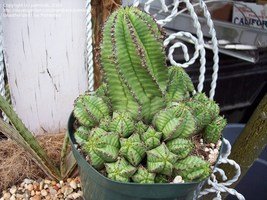
Euphorbia anoplia flowering; plant growing in far too much shade (narrow, pinched tops); plant growing in full sun
Euphorbia atrispina is not commonly cultivated, but it is relatively hardy. I am not certain how to tell this plant from Euphorbia enopla except the latter seems more likely to branch and does not form the uniform clumps that Euphorbia atrispina does. Both have ornamental rows of soliary spines down the ridges of the columns, with the uppermost, newest spines having a nice red color. This species has columns about 1 1/2 inches in diameter, just a bit thicker than those of Euphrobia enopla. Cold hardiness is down to about the mid-20s F.
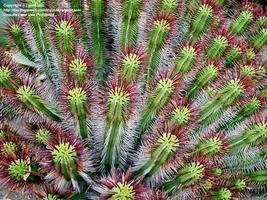
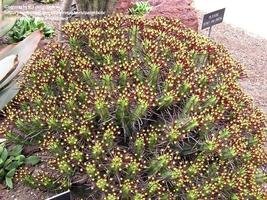 Euphorbia atrispina in botanical gardens
Euphorbia atrispina in botanical gardens
Euphorbia baioensis is moderately tall (12 inches or more), prolifically suckering, thin (less han 1/2-inch diameter), heavily armed (paired spines) and very symmetrical plant. I thought for several years this was a cactus species until I looked at the spines more closely. Plants are approximately 8 sided and occasionally can branch. This plant grows well with some slight overhead protection, but it still is not a good outdoor plant, being cold hardy barely below freezing. I include it mostly because it's commonly available and I have tried it over and over (all ending in failure).
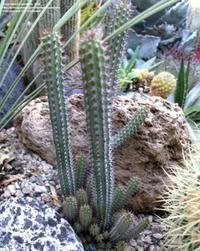
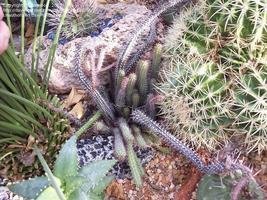
Euphorbia baioensis in my yard, before and after freeze
Euphorbia bupleurifolia is a popular species and always shows up in the cactus/succulent shows, and often wins. It is a short, globular/columnar species with a knobby, non-spiny surface and (most of the year) a nice, bluish-green head of spatulate leaves. I have had these rot outdoors and it is quite marginal in my climate. However it is fairly small, easy to keep in a pot, and move indoors if frost threatens it. This one is cold hardy down to about 28F, but keep it dry.
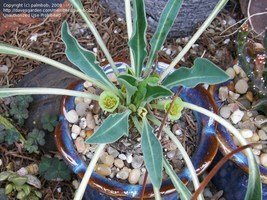
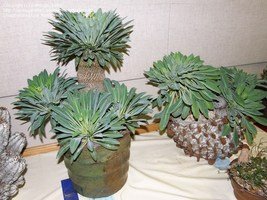
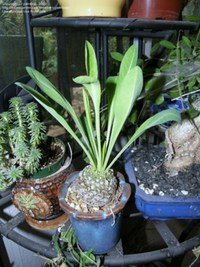
Euphorbia bupleurifolia in my yard large, old show plants my own dinky plant
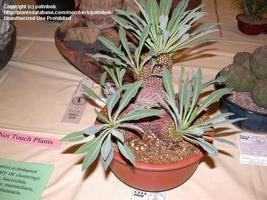
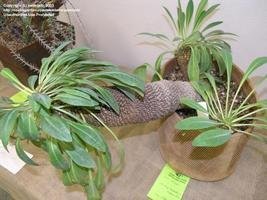 two more show plants
two more show plants
Euphorbia boranensis is a relatively new species for me and I have a couple growing outdoors; so far, it has performed better than expected. It is a skinny, four-sided plant with ornamental variegation and almost imperceptible spines. It's a great plant and I hope it will prove to be a survivor.
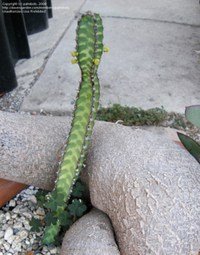
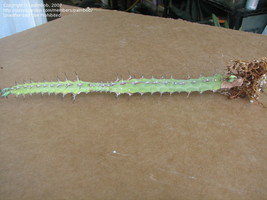
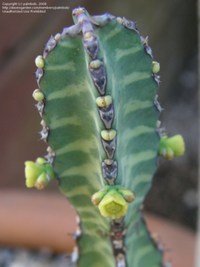
Euphorbia boranensis in my yard; mail order plant with more spines than others; close up showing flowers and striping
Euphorbia clandestina is one of my favorite species for outdoor landscaping and I find it quite hardy and easy to grow. It is a columnar, occasionally offsetting or even branching, knobby-surfaced plant with a head of skinny bluish-green leaves most of the year (this one rarely goes deciduous on me). The knobby surface tends to look like a large swirl up and down the column making for an attractive ornamental effect. Eventually these plants get too tall and fall over, and continue to creep along the ground. I have had them set seed and show up in various other places about the yard (a rarity in my climate for a Euphorbia to spread itself about). This species is very drought-tolerant and sun-hardy; plants grown in shady conditions get thin, very green and look like a totally different species. This plant is quite cold-hardy and 25F did not affect it in my yard.
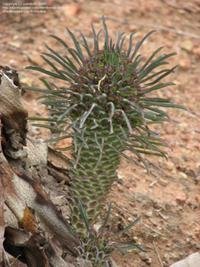
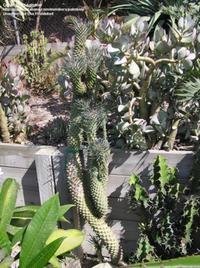
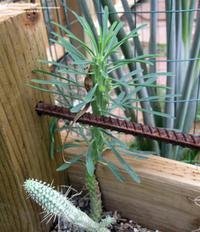
Euphorbia clandestinas (last show show etiolated, or stretched, plant growing in too little sun)
Euphorbia desmondii, though potentially a tree, is a dinky plant in my yard, about twelve inches tall and slow growing. I didn't even know it could become a tree until I saw a photo in the plantfiles of one in India. Wow. But I have a feeling in my climate this will be a small plant all its life. What is unusual about this 4-sided spiny, columnar plant is that it has leaves year round, even in cold winter... and the leaves continue to look good year-round. It may become a good plant for the future in southern California if we can just live long enough for it to grow large. Cold-hardiness is guessed to be in the high 20s (but could be better).
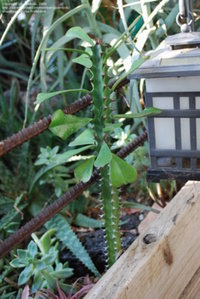
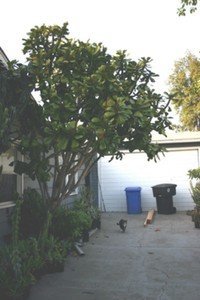
Euphorbia desmondia in my yard, and in tropical climate (photo by ScottBB)
Euphorbia echinus is a moderately large columnar, cylindrical, branching plant up to 2 feet tall and heavily armed, pale to mid-green branches/columns about 2 to 2 1/2 inches in diameter. Very sharp, 1/8-inch, closely spaced, paired spines run down about 7 to 8 ribs on each column/ branch. Yellow or maroon flowers in late summer to fall (don't know why, but all California plants have maroon flowers). This plant appears to be quite cold hardy, to at least 25F if not lower. Commonly available (but rarely, if ever, identified).
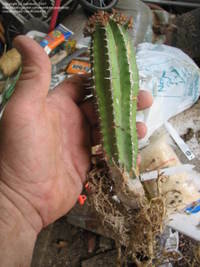
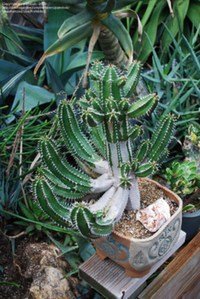 Euphorbia echinus
Euphorbia echinus
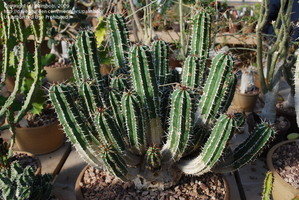
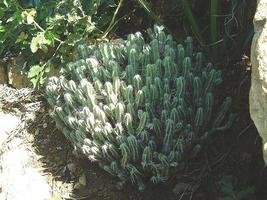
Very similar Euphorbia, Euphorbia officinarum, is shown here because I get these confused. Obviously also a hardy Euphorbia, but I have no personal experience with this one (second photo by RWhiz)
Euphorbia enopla is a branching, tubular bright, light green shrub up to 18 inches tall characterized by a somewhat regular row of 1-inch reddish spines along each of 5 to 7 ribs of the ¾-inch diameter branches. It looks a bit like an elongated, thin, organized, extra-spiny Euphorbia ferox. I often confuse this one with Euphorbia atrispina, which has very similar shaped and spined columns. Cold hardy to about 26F or perhaps lower.
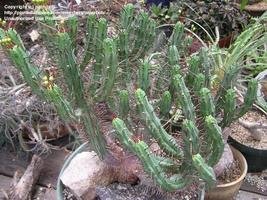
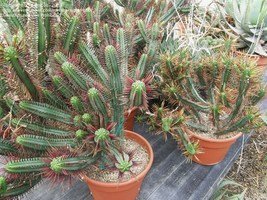
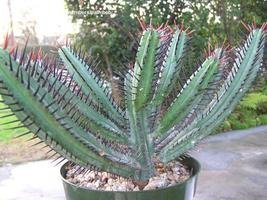
Euphorbia enoplas
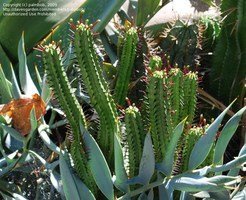
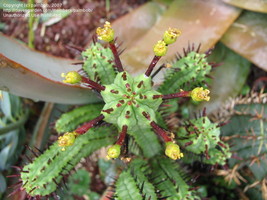 Euphorbia enoplas in my garden
Euphorbia enoplas in my garden
Euphorbia ferox is a common plant I refer to often as it has some very common characteristics. It is a very cold hardy (probably down to the very low 20s), short (5 inches tall) suckering and sometimes branching cylindrical plant about 1inch in diameter with stout, solitary, somewhat randomly spaced pink-purple to pale spines 1-inch long along each of its 6 to 7 poorly to strongly defined ridges. Despite this being a very common plant, and my having grown this for many years, I have yet to see it flower in southern California. This plant is very common and almost always available at garden outlet stores, even occasionally being properly identified.
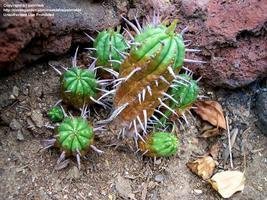
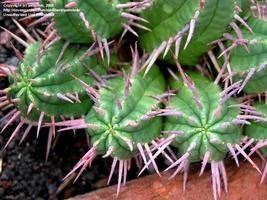
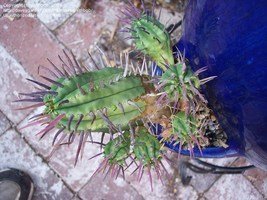
Euphorbia ferox in garden, pot planter box and pot
Euphorbia frankii is a relatively uncommon plant in cultivation, and not a great landscape plant thanks to its diminutive size. But it has proven to be a pretty tough species and probably a relatively hardy one for pot culture. It has short, globular columns with itty sharp, randomly spaced spines, sort of like a miniature version of Euphorbia ferox. This one has taken temps in the high 20s without any damage, but I don't know how much more it can take.
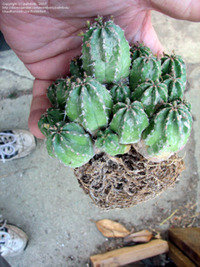
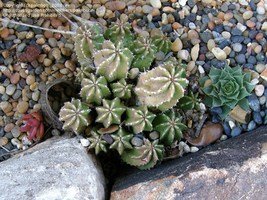 Euphorbia frankii in my garden
Euphorbia frankii in my garden
Euphorbia globosa. I debated whether to include this one here as it is such an oddly shaped plant. But it is globoid, though it is really multiglobular. It is an amazingly tolerant plant, handling cold down into the lower 20s, and handles sun, heat, drought and physical abuse as well (I had one that was driven over and it quickly grew out of the damage). Euphorbia pseudoglobosa is another cold-tolerant and similarly shaped plant, without the central spherical mass.
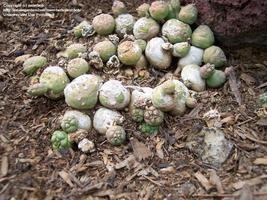
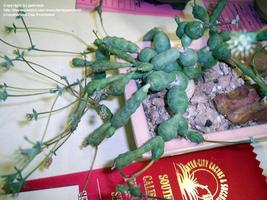
Euphorbia globosa in landscape show plant identified as Euphorbia globosa, but could be Euphorbia pseudoglobosa
Euphorbia heptagona is an easy-to-grow, deep green, cylindrical plant--very sparsely spined and about 1/2-inch in diameter. It is a suckering and branching plant about 6 to 10 inches tall with tiny leaves down the ridges of the top inch or so of each column (5 to 7 ridges per column). This plant is often confused with Euphorbia mammillaris (which has similarly irregularly spaced solitary spines, but a bumpy surface, not smooth like Euphorbia heptagona). Cold hardy to about 25F. Moderately available, though rarely if ever identified.
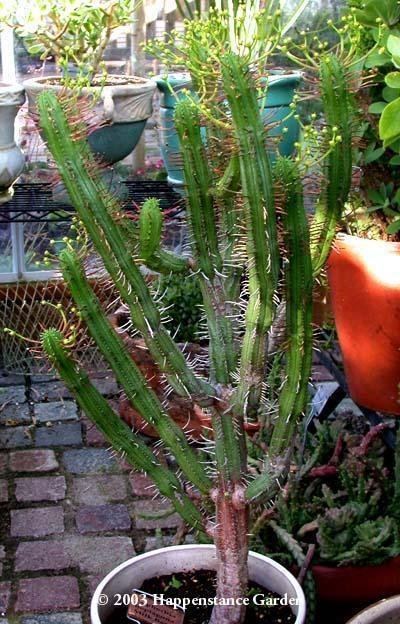
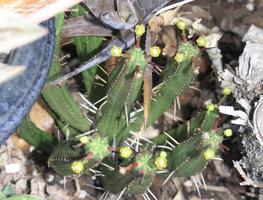
Euphorbia heptagona (photo by Happenstance) plant in my garden flowering
Euphorbia horrida is a very common species and an excellent choice for growing in arid, warm climates outdoors. It is hardy down to at least 25F and perhaps lower--I have not had one struggle with any cold I have ever experienced here in Los Angeles county, Southern California. This is a globoid columnar plant with a variety of colors and spinations available in cultivation. I am not an expert on official varietal names, but some include Euphorbia horrida 'Snowflake' (a pale-blue version with few spines), Euphorbia horrida 'Major' (a large species with many long spines covering the upper portions of the plant's surface), and Euphorbia horrida noorsveldensis (not exactly sure how this plant is unique from Euphorbia horrida var. horrida). I am sure there are more. This species is often confused with another common columnar Euphorbia, Euphorbia polygona. The latter tends to be a faster grower, has slightly narrower columns (not always true), is less spiny (though there are intensely spiny versions of Euphorbia polygona), have neater ‘rows' of ridges up and down the columns (another vague generalization) and have purplish, maroon or brownish flowers (this is the best identifier) compared to Euphorbia horridas' greenish to yellow flowers. Euphorbia horridas can grow quite large eventually and don't really fit the ‘small columnar' description. But most acquire these as relatively small plants. They are fairly slow growing, too, so stay smaller for many years. They are prolific offsetters, but the Euphorbia horrida 'Major' variety seem to remain solitary, at least for many years. These need a lot of heat and sunlight to do well, but tolerate cold winter rains well in southern California.
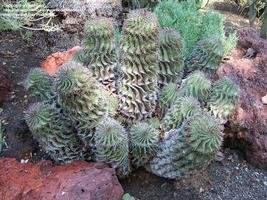
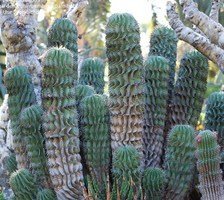
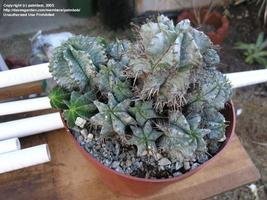
Euphorbia horrida specimens at the Huntington Gardens Euphorbia horrida 'Nova'
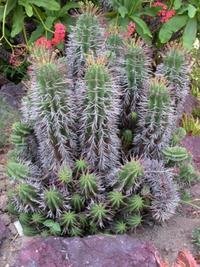
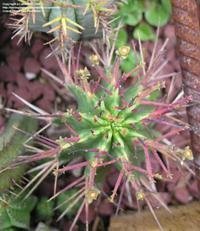
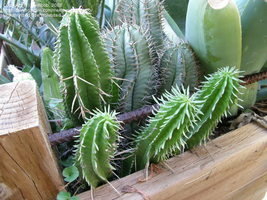
Euphorbia horrida var. Noorsveldensis
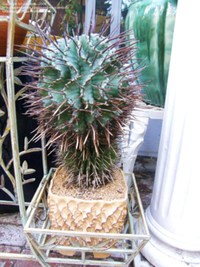
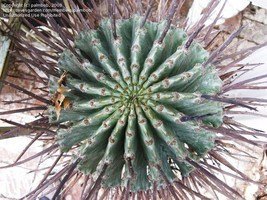 Euphorbia horrida 'Major'
Euphorbia horrida 'Major'
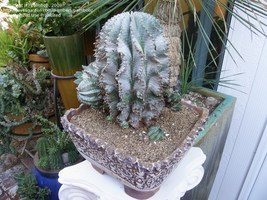
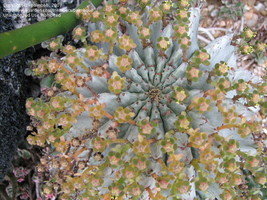
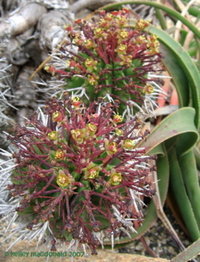
Euphorbia horrida 'Snowflake' Euphorbia horrida flowers (last photo by Kell)
Euphorbia inconstantia is a Euphorbia horrida lookalike (to me), though it has neater edges and more consistent spination. So far it is proving to be a pretty hardy and reliable plant, both in pots and in the ground. It is also fairly common and most of mine have come from commercial garden outlet centers, usually labeled ‘succulent' or sometimes Euphorbia horrida or E. polygona. It has a good turquoise color and is a moderately fast grower, eventually forming a dense city of pale turquoise columns.
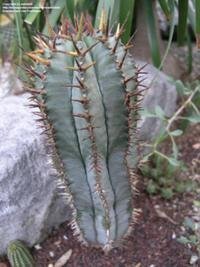
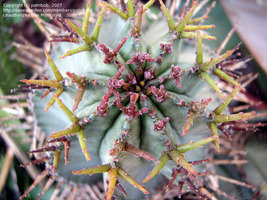 Euphorbia inconstantia
Euphorbia inconstantia
Euphorbia jansenvillensis is another small globular/columnar species that seems quite content in our cold, Mediterranean climate. It prefers full sun, but grows fairly well in lower light situations (just getting etiolated in the process). No spines, small and bright green make it a good and user-friendly attractive potted plant.
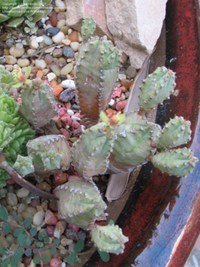 Euphorbia jansenvillensis
Euphorbia jansenvillensis
Euphorbia makallensis is a look-alike plant to the much more common species, Euphorbia resnifera. It differs in having less prominent spines and is somewhat shorter, stouter and slightly darker. But, like Euphorbia resnifera, this species can form large colonies of wonderfully uniform plants. My own plant is growing in a very marginal climate (this plant is much wimpier when it comes to cold compared to Euphorbia resnifera) and it is hardly getting any larger. It also has branched a few times making it look a bit less uniform. This is probably a better pot plant, in my climate, than a landscape species.
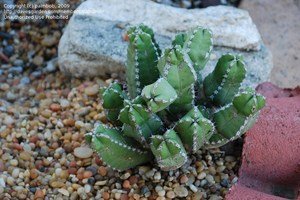
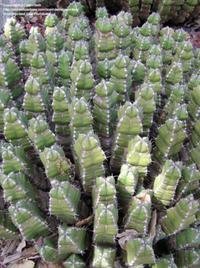
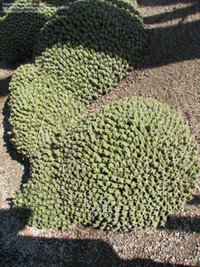
Euphorbia makallensis in my garden colony appearance huge colony in southern California
Euphorbia mammillaris. Most collectors and growers of succulent plants will recognize this species as it is one of the most commonly offered of all the small Euphorbias. It is a prolific offsetting species with narrow columns, sometimes with columns growing out of the sides of other columns. It is of uniform diameter--usually about 2 cm (nearly an inch) with narrow grooves and segmented, giving it the appearance of a corncob (hence its common name, the Corncob Euphorbia). Spines are solitary and irregularly spaced. There are variegated and non-variegated forms, but by far the most popular are the whitish, variegated types. These tend to turn an attractive pink near the tops when it gets really cold, or the plant is stressed in other ways. This is a moderately thirsty Euphorbia and I have killed a few by not watering them enough. It also needs a lot of sun, even the variegated forms.
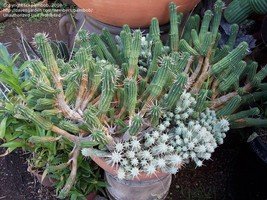
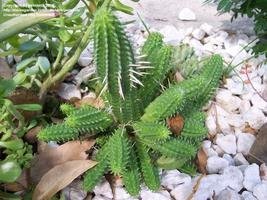
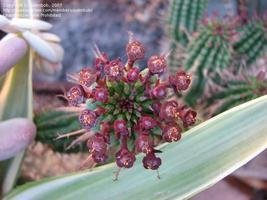
Euphorbia mammillaris 'normal type' growing with a small clump of variegated form; middle photo is of young plant in my garden; flowers
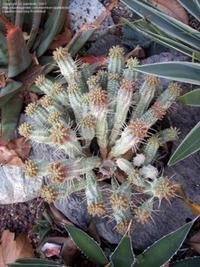
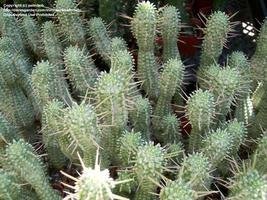
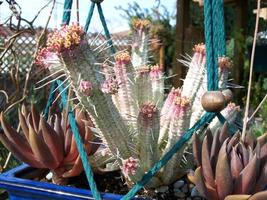
Euphorbia mammillaris variegated form
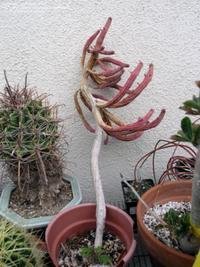
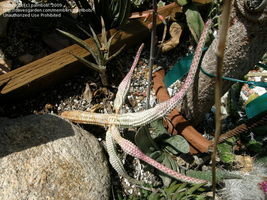
variegated form old plant (left) and plant grown in too much shade (right)
Euphorbia mayuranathani is still a fairly rare plant in cultivation, but surprisingly hardy considering how tropical it looks. It's a branching, smooth, bright, light green species with wonderful inconsistent shapes and turns. I have a feeling that in India it became a fairly large tree, but it supposedly is extinct there now. Fortunately it can now be found online from several sources.
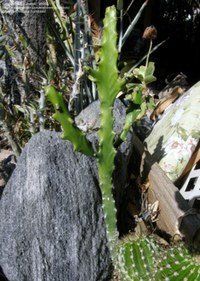 Euphorbia mayurananthii in my garden
Euphorbia mayurananthii in my garden
Euphorbia milii, aka Crown of Thorns, is an extremely popular and common species and deserves its own article. There are hundreds of cultivars but interestingly these seem to vary markedly in their cold hardiness. I have several in the yard and most have long since melted at just the threat of freezing temps while a few others have barely seemed affected at all. The smaller-flowered forms in general seem to be the hardiest, but I don't have enough experience to say that is always the case. These smaller plants become deciduous in the high 20s, and get severely damaged by the mid-20s. Surely the exotic, large-flower beauties from Thailand are hopeless in my climate and are strictly indoor plants in winter here. This is an extremely spiny species (hence the name) and tends to stay leafy all year round, eventually forming large, impenetrable shrubs with age.
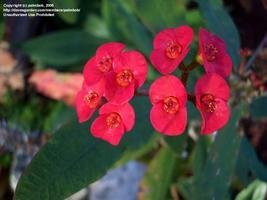
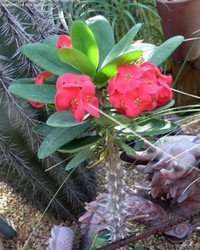
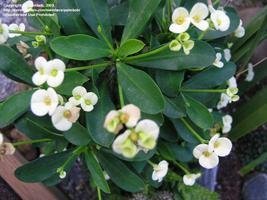
Euphorbia milii varieties in my garden (common red left), a Thai cultivar in middle (since died in mild cold spell) and 'Helena' (right photo)
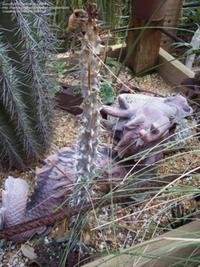
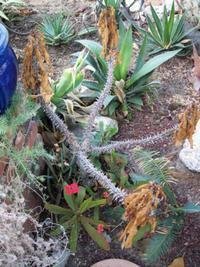
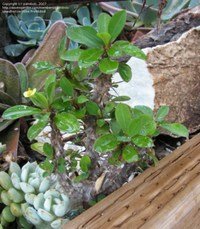
Dead Thai hybrid (left) after 28F; defoliated by alive form after 25F; dwarf plant didn't even defoliate at 26F
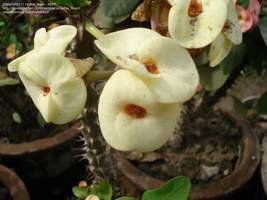
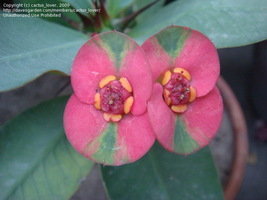
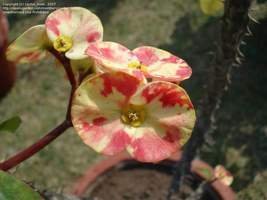
examples of three hyrids of Euphorbia milii : 'Charoen Roongroeng', 'Salmon' and 'Millionaire' (all photos by cactus_lover)
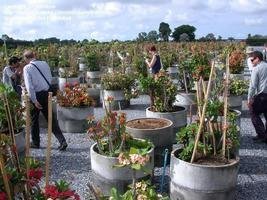
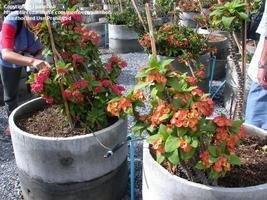
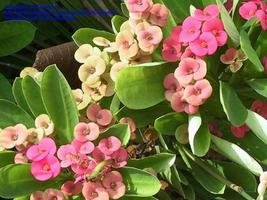
over an acre of Euphorbia milii hybrids grown in Thailand (Nong Nooch Gardens); colorful display growing in MidEast (photo Chamma)
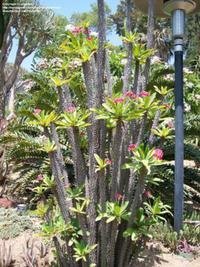 Many crosses exist with this species. This is Euphorbia milii X lophogona
Many crosses exist with this species. This is Euphorbia milii X lophogona
Euphorbia neohumbertii is a somewhat tropical species that just can't quite make it in my yard unless put in just the right spot. But it is a nice plant with flat, angular sides lined with closely spaced, not-terribly-sharp spines and topped with large, tropical-looking leaves and bright red cyathea. I also have a similar species in the yard, Euphorbia viguieri, that seems subtly hardier (so far) though still obviously somewhat marginal. Both are Madagascan Euphorbias and most of those tend to be pretty frost tender. Both also seem perfectly at home in warm humid climates.
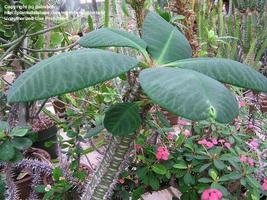
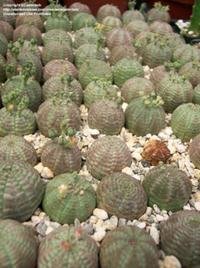
Euphorbia neohumbertii growing in greenhouse with nice summer leaves; outdoor plant in southern California in winter flowering and leafless
Euphorbia obesa (aka Baseball plant) is a very popular and commonly offered species of Euphorbia. I have several of these about the yard and though most are doing well, I have lost some in the past to cold so bring the largest, most expensive ones indoors under threat of frost. It is a spherical to columnar solitary to suckering plant with no spines or really any external features other than subtle small ‘zipper-like' patterns down the sides. It is a wonderfully curious ornamental beast and one of my favorite of all the Euphorbias. However it is only cold hardy just below 28F, and resents excess watering in winters (though rain water seems to be OK if soils are well draining and it's not actually freezing). Euphorbia symmetrica is a very similar looking plant that tends to remain spherical and stay smaller even with age. I personally cannot tell the two apart when they are the same size and shape. I have no experience with this latter species.

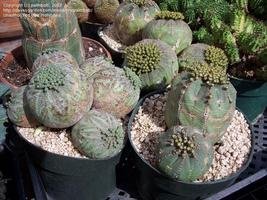
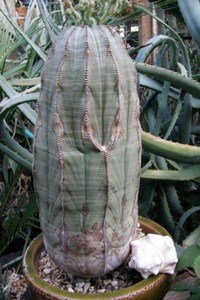
Young Euphorbia obesas in nursery; older plants flowering; very old plant in my garden
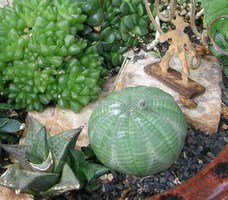
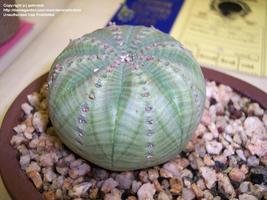 Euphorbia obesa on left and Euphorbia symmetrica on right
Euphorbia obesa on left and Euphorbia symmetrica on right
Euphorbia pillansii is a moderately large, many-sided, tubular columnar plant and quite hardy in my experience. Not any of my plants have ever shown cold damage, even down to 25F for extended periods. It is a bright green species with new red spines (not unique) and grows easily3 to 4 feet tall (that is more unique) and it branches some. I got all mine as give-away cuttings from people who had large shrubs of it and needed to thin them out. I am sure I will eventually be doing the same.
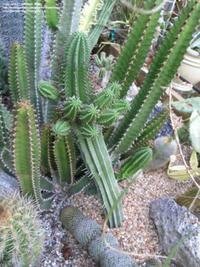
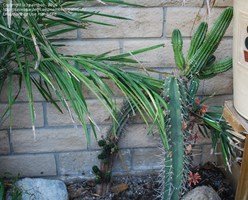
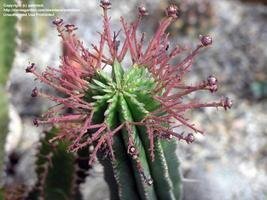
Euphorbia pillansiis in my yard
Euphorbia polygona is another very common species in cultivation, frequently offered at garden outlet centers in several forms. Euphorbia polygona is often mistaken for Euphorbia horrida, which it is quite similar in overall shape and size. These tend to be somewhat neater plants with straighter columns of uniform diameter. These plants grow a bit faster than do Euphorbia horridas and offset prolifically eventually forming small, closely spaced colonies of symmetrical columns. Some forms have numerous modest spines along the ridges, and some forms have no spines whatsoever. There is a Snowflake form (as there is of Euphorbia horrida) that is nearly white and is invariably spineless. It is a beautiful plant but commonly available. These plants are fairly hardy for columnar Euphorbias and seem at least as cold tolerant as do the Euphorbia horridas, down to about 25F or less. They need plenty of heat, but do not seem as demanding of direct sunlight as Euphorbia horrida, though it seems to be happiest in full sun.
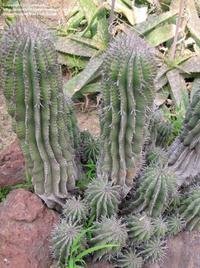
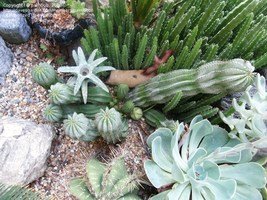
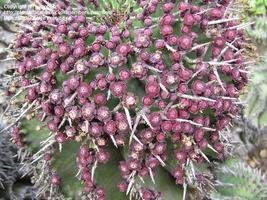
Euphorbia polygona
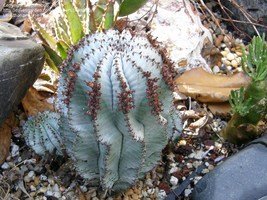
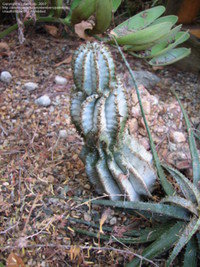 Euphorbia polygona 'Snowflake' (right photo of plant in too little sun)
Euphorbia polygona 'Snowflake' (right photo of plant in too little sun)
Euphorbia pseudoglobosa is peculiar and very similar plant to Euphorbia globosa both in terms of flower shape and size as well as its randomly, globular branching habit. Only this one has more tubular structures and less spherical to ovoid structures. Cold hardiness seems impressive, but mine have not seen temps much lower than 26F yet.
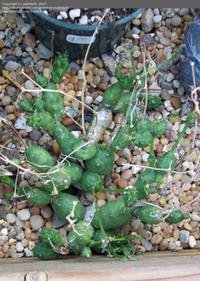
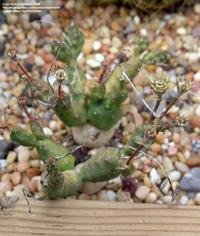
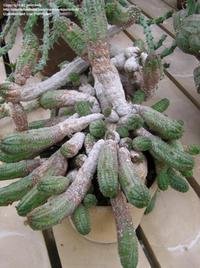
Euphorbia pseudoglobosa in my garden; flowering; old plant in Huntington collection
Euphorbia resnifera is one of the hardier columnar Euphorbias, slow growing but persistent and eventually forming large, uniform colonies of square, spiny sea-green plants. This species rarely branches, but it can, and it's one of the better landscaping species of the smaller columnar Euphorbias.
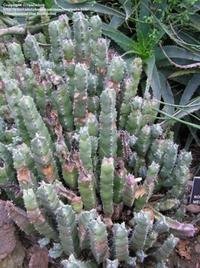
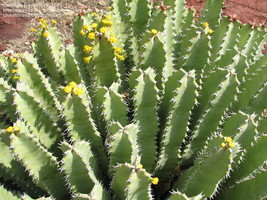
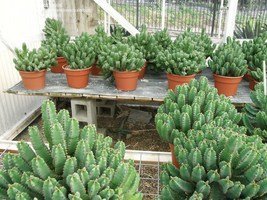
Euphorbia resniferas
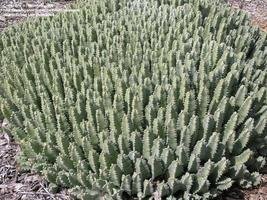
 Euphorbia resnifera in large colony
Euphorbia resnifera in large colony
Euphorbia spiralis. I have had one of these for years and it is a very hardy, small, columnar, branching, deep green plant with a spiral pattern, and some sparse leaves for some of the year. It is not one of my favorites as it's sort of a haphazardly growing species, but it would make a nice potted plant (mine is in the landscaping and most of the cool spiraling effect is lost).
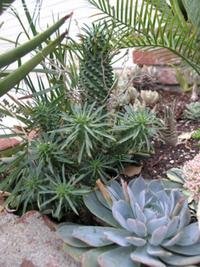 Euphorbia spiralis in my garden
Euphorbia spiralis in my garden
Euphorbia stellaspina is a fairly common species in cultivation, though not so common I run into it often at Home Depot. It is a typical columnar stemless Euphorbia with atypical, complex spines that are branched and evil-looking. It is a highly ornamental species and old plants are impressive, having numerous closely spaced columns and wonderful spines. The body of the plant is also a nice pale green color. So far I have yet to see any cold damage even at 25F.

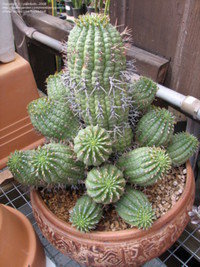 Euphorbia stellaspinas
Euphorbia stellaspinas
Euphorba submammillaris is another colony-forming Euphorbia mostly consisting of short, 2- to 4-inch tall, somewhat cylindrical, spineless columns. I have found this one an easy plant to rot, but I have been able to grow it in a pot. It needs a lot of sun, but it seems pretty cold hardy (25F or less)... just not tolerant of overwatering in summer. Form 'Pfersdorfii' is a minature version of this and and extremely touchy plant--every one I have touched has rotted in no time. Cold hardiness seems less impressive, too (damage at 28F).
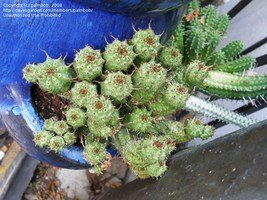
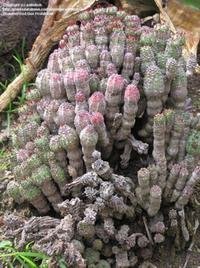
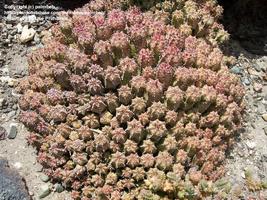
Euphorbia submammillaris
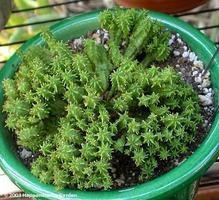
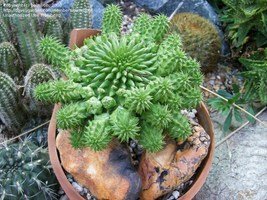 Euphorbia submammillaris 'Pfersdorfi'
Euphorbia submammillaris 'Pfersdorfi'
Euphorbia susannae is another very popular species thanks to its compact nature and ease of growth. It is not the hardiest species and does have trouble with temperatures in the low 20s, but it is small enough to easily take indoors if need be. It is a bright green, spineless, aggressively clumping species that almost never looks the same as the next individual (all the ones I have look so different it's hard to believe they are the same species). Great potted plant.

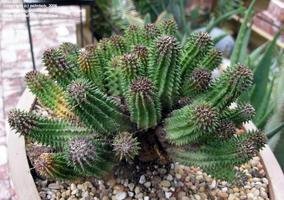
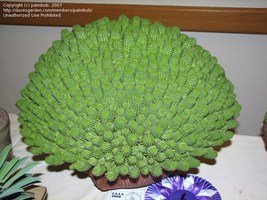
Euphorbia susannaes
Euphorbia vallida. This plant looks a lot like Euphorbia obesa with a wild striped variegation on it, though it does have a slightly more angular appearance, and some remnant dried flower stalks on the top of the plant. Cold hardiness seems more impressive than Euphorbia obesa, but it has not really been tested in my yard.
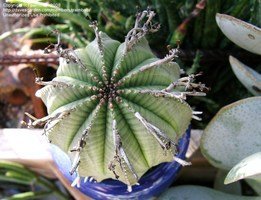
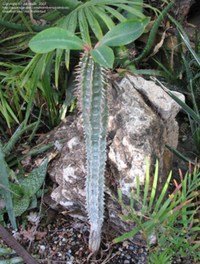
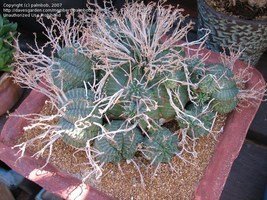
Euphorbia vallida (my own) extra nice show plant old plant with retained flower stalks
Euphorbia viguieri is a similar Madagascan species to Euphorbia neohumbertii and little more to be said other than so far it has done a bit better for me than the latter species has. Still, quite marginal. Best to be taken indoors in winter unless one lives in a warm 10a, or a 10b or higher.

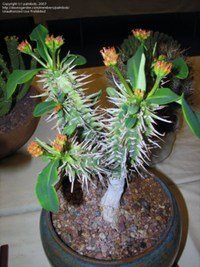 Euphorbia viguieri (mine, and a show plant on right)
Euphorbia viguieri (mine, and a show plant on right)
Euphorbia sp. 'Mrs. Ash' is a hybrid species with unknown origins (to me at least) that I have seen in several collections and now have one in the yard. It is surprisingly hardy and moderately fast growing. It is a branching, columnar, creeping species with sparse, upward short, but sharp spines and a nice, subtle variegated pattern. It may be a thick, sparse-spined form of Euphorbia actinoclada, another plant I have in the yard, but have too little experience yet to include in this article.
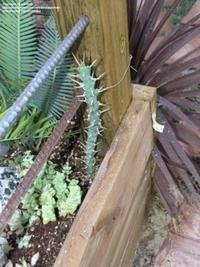
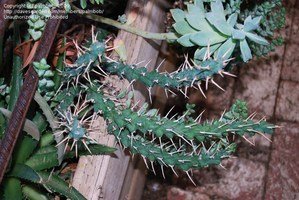
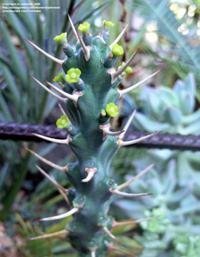
Euphorbia sp. 'Mrs Ash'
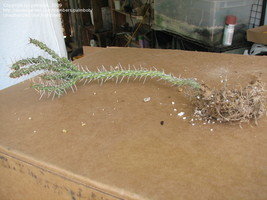 Euphorbia actinoclada (just got it mail ordered in this photo)
Euphorbia actinoclada (just got it mail ordered in this photo)
Euphorbia sp. 'William Denton' is a Euphorbia obesa hybrid (I think) that grows more columnar and seems to have more cold hardiness. It is an attractive species, but no match for Euphorbia obesa.
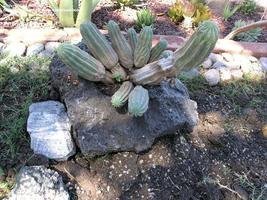
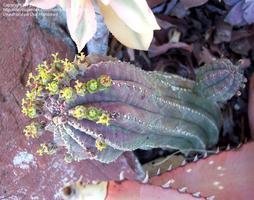 Euphorbia sp. 'William Denton'
Euphorbia sp. 'William Denton'
Euphorbia 'Wundulate' is a hybrid of Euphorbia horrida ‘Nova' and Euphorbia polygona ‘Snowflake'... and an exceptional potted and landscape species. It has the greenish flowers of Euphorbia horridas, but the nearly pure white coloration of the Euphorbia polygona 'Snowflake'. It's symmetry tends to be in the middle between Euphorbia horrida (very wavy-edged plant) and Euphorbia polygona (a relatively straight-edged plant). It has what I call hybrid vigor in that is always looks good, grows faster than either parent, and seems to be at least as hardier as either, if not more so. This plant is safe outdoors at least down into the low 20s.
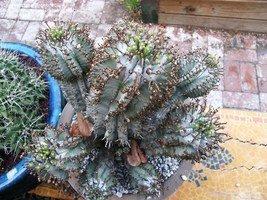
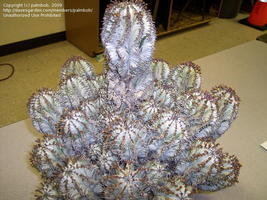
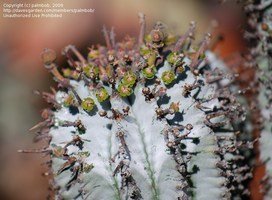
Euphorbia sp. 'Wundulate'
I also have several unknown species in my yard that are doing quite well, but I cannot seem to get them identified. Below are some photos of them--if you know what any of them are, please let me know.
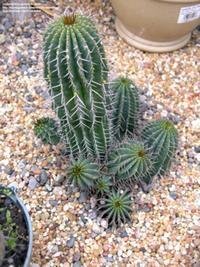
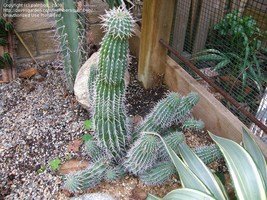
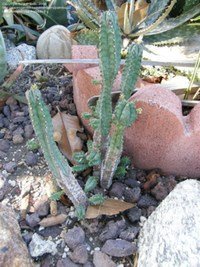
This first plant was called Euphorbia echinus, but it's obviously not. No problems with cold, though; plant on right: who knows... hardy, though
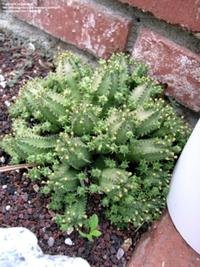
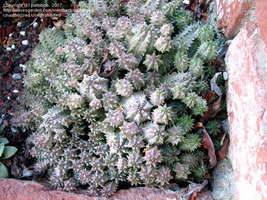
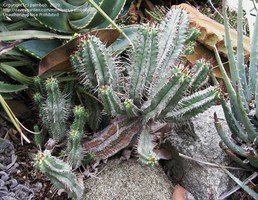
This small Euphorbia in first two photos is very hardy, but what is it? This plant in right photo is like a giant Euphorbia enopla... hardy
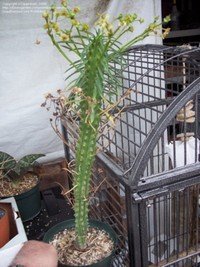
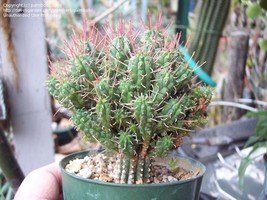
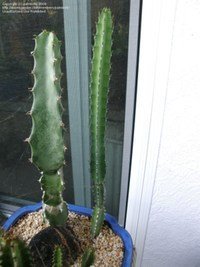
Euphorbia clava? form of Euphorbia mammillaris? I know these two in last photo: just including them since plant on right is Euphorbia elegantissima, which seems mildly hardy, maybe, but the one on the left is Euphorbia roebechii, which I can attest is NOT hardy (low 30s rotted this one)
Copyright © www.100flowers.win Botanic Garden All Rights Reserved